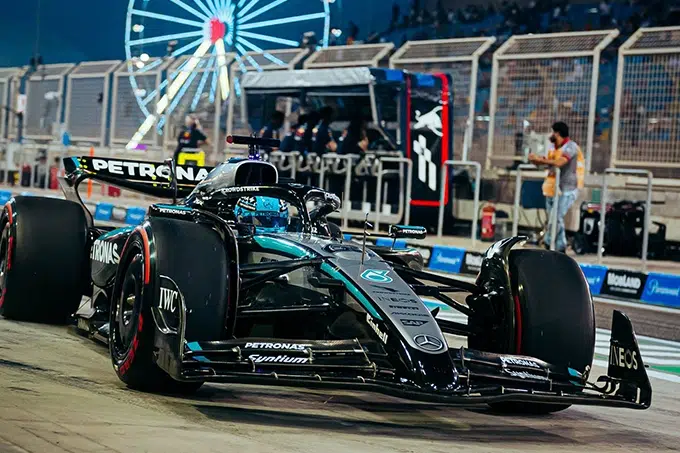George Russell’s Bahrain GP was far from smooth, as Mercedes uncovered critical electronic faults that nearly cost him a podium finish.
The investigation continues as the team digs into mysterious electronic failures.
Mercedes is still trying to unravel the mystery behind the issues that hit George Russell’s car during the Bahrain Grand Prix last weekend.
Despite finishing second, Russell experienced a major electronic brake system failure midway through the race. On top of that, his Drag Reduction System (DRS) had to be operated manually, after a strange fault disrupted the timing loop that controls DRS activation. The core of the problem? A scorched timing transponder found onboard.
“It might’ve looked like the problem started in the final ten laps,” explained Mercedes’ communications chief Bradley Lord, “but the reality is it began much earlier—around halfway through the race.”
Back at the factory, the team returned with cases full of parts for analysis. Among them: a charred transponder linked to the FIA’s official timing system, and several components related to the electronic brake control unit.
The first clue something was wrong came when Russell’s name suddenly vanished from the second place spot on the team’s timing screens.
“We saw his name drop off the board and thought: hold on, he’s still out there and talking to us. That’s when we realized it was a transponder issue, not a racing one,” Lord said.
But that glitch triggered bigger consequences. The DRS relies on timing data to know when to activate—specifically, whether a car is within one second of another. Without that data, Russell had to switch to manual DRS.
“We consulted the FIA and got approval for George to use a manual backup mode for the rest of the race,” Lord confirmed.
Things didn’t stop there. Around the same time, another unrelated problem struck: the car’s brake-by-wire system began to fail.
“The electronic braking system controls the balance between the front and rear brakes, with the rear supported by the MGU-K (the electric motor) and the hydraulic brakes,” Lord explained. “When the electronic system drops out, you lose the electric assistance and rely fully on the hydraulic brakes—much smaller and prone to overheating.”
Russell had to juggle default settings manually, turning electronic braking on and off depending on the car’s condition—sometimes up to 30 times during the final ten laps.
“And he still held off both Leclerc and Norris,” said Lord. “He was managing his braking points while making split-second decisions every few corners. It was really something to watch.”
There were additional concerns that the timing issue might disable Russell’s steering wheel display, which shows crucial data during the race. Luckily, that didn’t happen. But an odd moment did occur when he accidentally activated the DRS while trying to use the backup radio button.
“That button serves as both an emergency radio and a manual DRS control. George hit it down the back straight and unknowingly opened the DRS,” Lord explained. “He caught it immediately, hit the brakes, closed the DRS and carried on. The stewards reviewed it and agreed there was no intent to cheat.”
In the end, Russell wasn’t penalized. His ability to handle such a chaotic situation left the team deeply impressed.
“He was like a circus performer spinning plates,” Lord concluded. “To stay calm under that kind of pressure, manage all those systems manually, drive flawlessly, and still finish on the podium—it was a phenomenal performance.”

- Discover More>Tsunoda Eyes Consistency As He Tackles RB21 Learning Curve
- Follow us on >FACEBOOK and >TWITTERfor F1 update
Burnt Transponder Blamed for Russell’s Bahrain Woes Burnt Transponder Blamed for Russell’s Bahrain Woes
